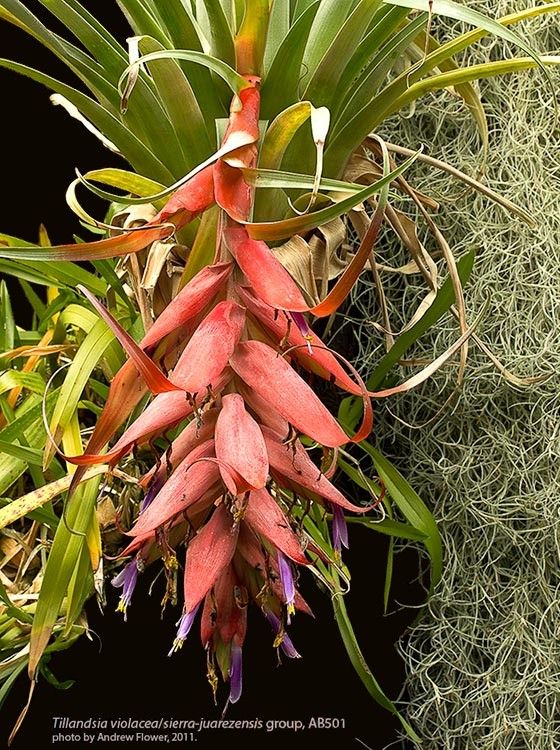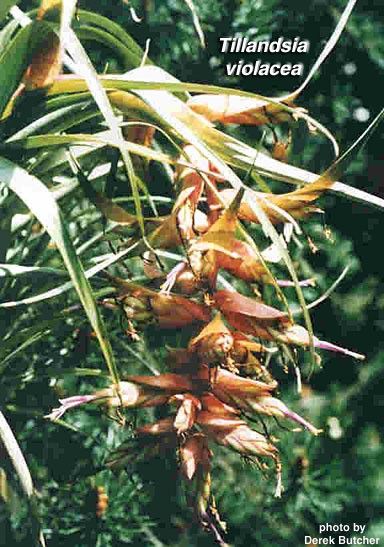

By Gardner 1982
TILLANDSIA VIOLACEA J.G.Baker, Jour. Bot. London 25:279, 1887 (fig. 90). TYPE Andrieux 60 (holotype K, GH photo, isotype M, n.v.) Toluca, Mexico, Mexico 1834.
Synonym: Tillandsia sierrajuarezensis Matuda, Cact. Suc. Mex. 18:2, fig. 24, 1973. Type: Matuda 38420 (MEXU) in humid cloud forest of la cumbre de la Sierra de Juarez,.0axaca, Mexico, at 2,000 to 2,300 meters elev. 1972.
ROSETTE: Spreading, funnelform, impounding, 30 to 60 leaves, rarely offsetting. LEAF: 48 cm long.
BLADE: 25 mm wide, triangular, appressed lepidote, green, slight metallic sheen.
SHEATH: 13 cm long, 84 mm wide, adaxial surface pale brown, abaxial surface brown, color tends to vary between populations.
SCAPE: Elongate, shorter than leaves, stout, deflexed.
SCAPE BRACTS: Imbricate, laminate,
PRIMARY BRACTS: Lowest long laminate, upper apiculate, sheaths of all about equal to and partially enfolding the branches, #26 rose.
INFLORESCENCE: Pinnate, to 30 branches, Internodes between lowest branches distinct in some populations, very short in others, pendent.
BRANCHES: Elliptic, sessile, thick. Large bicarinate sterile bract adjacent rachis.
FLORAL BRACTS: Ovate, convex, imbricate, coriaceus, scattered scales on both surfaces, #26 rose, pigment in dots, 33 mm long, 18 mm wide.
SEPALS: Lance-ovate, membranous with thick midrib, glabrous, green, free, 30 mm long, 10 mm wide, posterior carinate.
PETALS: Weakly spatulate, erect, claw thick, ,#42 lavender with white edges, 51 mm long, 9 mm wide.
FILAMENTS: #42 lavender, 56 and 59 mm long. ANTHERS: 4 mm long, median attachment, pollen yellow, endothel ium yet low.
STYLE: 55 mm long, #42 lavender spots on apex.
STIGMA: #42 lavender, lobes loosely twisted, papillose.
FLOWERING: February - March, midday.
HABITAT: Epiphytic in pine forest in southern Mexico from Chiapas to Michoacan and Veracruz.
ELEVATION: 2,300 meters. Specimens from Oaxaca and Veracruz tend to have shorter internodes between the inflorescence branches and larger primary bract relative to the branches, resulting in a capitate inflorescence. Leaf-sheaths tend to be darker. The variation of these characters within populations makes it difficult to maintain these as distinct species. However, further comparison of specimens from these populations is needed.
Other material examined: MEXICO, Veracruz: Perote, 1957, Foster & VanHyning 2984 (US), Mexico: Cerros Tenayo, Sonayo, 1952, Matuda 26241 (MEXU, US), Michoacan: San Jose de la Cumbre, 1980, Gardner 1377 (US, SEL), Oaxaca: Miahuatlan, 1980, Gardner 1269 (US, SEL).
Ehlers notes 1995
While T. violacea always offsets, has blue flowers, primary bracts enfolding the narrow side of the spike. The plant in the calendar is obviously a plant from Oaxaca, Sierra de San Felipe and Sierra de Juarez. It was described as T. sierrajuarezensis MATUDA. Gardner made the latter to be a syn. of violacea. First I thought this is not right as the differences in the description and in the plants are evident. (In the description of sierrajuarensis it is said spikes are complanate and the floral bracts are carinate, barely exceeding the sepals, but the bracts are said to be 3- 5 cm, sepals 2,5 cm.) Sue Gardner has a description of violacea in her dissertation that seems to be a mixture of both types of plants. Then I started to study a lot of material and found all plants very variable, you find plants with carinate bracts and nearly ecarinate ones. The plants from Sierra Juares have a short and stout infl. the internodes between the spikes are small. But there may not be enough difference to make a species as the description from Matuda is a little poor.